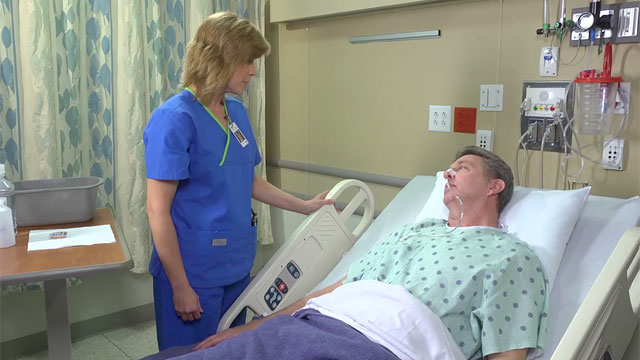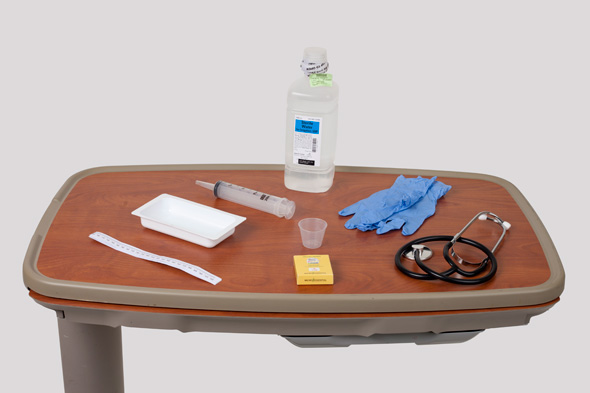Postoperative Nursing Care
Select a Skill:
Take the Review Test:

Safety
- Based on a patient’s clinical condition and agency policy, check the feeding tube position at regular intervals—often every 4 to 6 hours—and before administering formula or medications through the tube.
- Monitor the length of the tube externally, and observe the appearance, volume, and pH of the fluid aspirated through the tube.
- Be aware that some medications may discolor aspirate. If recently administered medications are not the source of the color, notify the health care provider. Reddish aspirate may indicate new blood in the GI tract. Aspirate with a brown coffee-grounds appearance may signify old blood in the GI tract.
- If the patient develops severe respiratory distress (such as dyspnea, decreased oxygen saturation, or increased pulse rate) as a result of aspiration or tube displacement into the lung:
- Stop any enteral feedings.
- Notify the health care provider.
- Obtain a chest x-ray as ordered.
Equipment
(Roll cursor over items to see labels)

60 mL catheter-tip syringe
Irrigation tray
Stethoscope
Clean gloves
pH indicator strip (scale of 0.0 to 11.00)
Small medication cup
Liter bottle of sterile water
Paper measuring tape
Delegation
The skill of irrigating a feeding tube may not be delegated to NAP. Direct NAP to report when a continuous tube feeding stops infusing. Verification of tube placement may not be delegated to NAP. Be sure to inform NAP of the following:
- Direct NAP to notify you immediately if any of the following occurs:
- The patient’s rate of respiration changes or the patient complains of shortness of breath, coughing, or choking
- The patient vomits or NAP notices vomitus in the patient’s mouth during oral hygiene
- Nasal skin irritation is present
- A change in the external length of the tube occurs, indicating possible tube displacement
Preparation
- Be aware of your agency’s policy and procedures for the frequency and method of checking nasogastric (NG) tube placement. Do not insufflate air into the tube to check placement.
- Identify the risk of spontaneous tube dislocation:
- Altered level of consciousness
- Agitation
- Reduced oxygen saturation
- Retching/vomiting/coughing
- Nasotracheal suctioning
- Observe the external portion of the tube for movement of the ink mark away from the mouth or nares.
- Assess the patient’s bowel sounds.
- Note the ease with which tube-feeding formula infuses through the tubing. Failure to infuse as desired could be a sign of a developing obstruction.
- Position the patient in the high-Fowler’s position, if tolerated, or the semi-Fowler’s position.
Follow-up
- Observe the patient for respiratory distress, including persistent gagging, paroxysmal coughing, and unusual respiratory patterns, such as a respiratory rate and depth that are inconsistent with baseline measures.
- Verify that the external length of the tube, the pH, and the appearance of the aspirate are consistent with the initial tube placement.
- Observe the ease with which the tube feeding instills through the tubing.
- Monitor the patient’s caloric intake.
Documentation
- Record and report the pH and appearance of the aspirate.
- Record the time of irrigation and the amount and type of fluid instilled.
- Report if the tubing has become clogged.
Review Questions
1. What would the nurse do if material aspirated from a patient’s nasogastric tube resembled coffee grounds in color and texture?
 Check the tube placement.
Check the tube placement. Assess the pH of the contents.
Assess the pH of the contents. The nurse must check NG tube placement before providing a scheduled tube feeding.
The nurse must check NG tube placement before providing a scheduled tube feeding. Irrigate the tube with water.
Irrigate the tube with water.
2. What would the nurse use to irrigate a patient’s nasogastric tube after providing medications?
3. Which instruction might the nurse give to nursing assistive personnel (NAP) regarding the care of a patient with a nasogastric (NG) tube?
 “Remember to aspirate 5 to 10 mL of stomach contents before flushing the tube.”
“Remember to aspirate 5 to 10 mL of stomach contents before flushing the tube.” “Let me know if the patient complains of anything related to the NG tube’s placement.”
“Let me know if the patient complains of anything related to the NG tube’s placement.” “Tell me if you see any vomit in the patient’s mouth during oral care.”
“Tell me if you see any vomit in the patient’s mouth during oral care.” “Please see if the NG tubing has advanced at all.”
“Please see if the NG tubing has advanced at all.”
4. What would the nurse do before providing the patient with a scheduled intermittent feeding through a nasogastric (NG) tube?
 Listen to bowel sounds.
Listen to bowel sounds. Listen to lung sounds.
Listen to lung sounds. Check NG tube placement.
Check NG tube placement. Turn the patient onto his or her left side.
Turn the patient onto his or her left side.
5. When checking gastric aspirate from an NG tube, the nurse assesses a pH of 7. What would the nurse do next?
 Nothing, since this is an expected pH value
Nothing, since this is an expected pH value Advance the tube
Advance the tube Anticipate a chest x-ray
Anticipate a chest x-ray Pull back on the tube
Pull back on the tube
You have completed the Review Questions for this skill. To take the Review again select the Start Over button. To proceed to another skill select from the dropdown menu. Select the Home or Back button to proceed to the next section.

